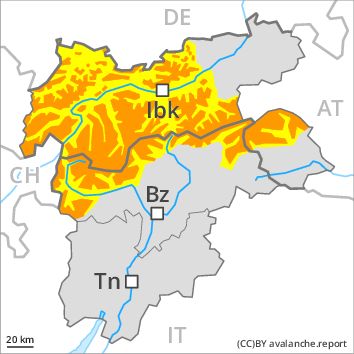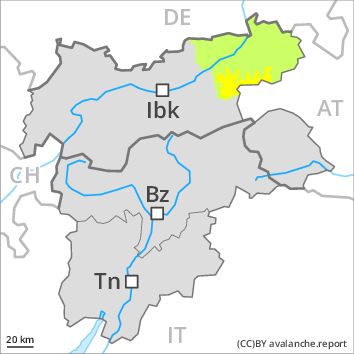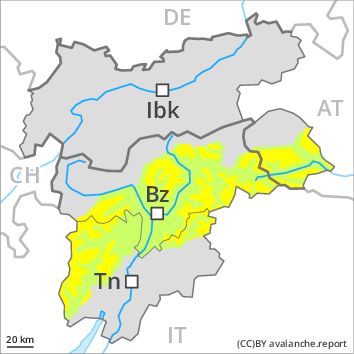Regions
Val Müstair Alps, Western Verwall Mountains, Langtaufers, Eastern Verwall Mountains, Schnals Ridge, Silvretta, Southern Stubai Alps, Samnaun Mountains, Southern Zillertal Alps and High Tauern, Northern Oetz and Stubai Alps, Saldurn-Mastaun Ridge, Western Tuxer Alps, Texel Mountains, Eastern Tuxer Alps, Glockturm Range, Durreck Range, Weißkugel Range, Western Rieserferner Mountains, Gurgler Range, Central Stubai Alps, Ortler Range, Northern Zillertal Alps, Allgäu Alps, Venediger Range, Eastern Lechtal Alps - Ammergau Alps, Mieming Mountains, Eastern Rieserferner Mountains, Karwendel Mountains, Glockner Range, Western Lechtal Alps, Central Lechtal Alps, Grieskogel Mountains

Danger level
Danger Level 3 - Considerable above 2300m
Danger Level 2 - Moderate above 2300m
Avalanche Problem
Wind-drifted snow above 2300m, N-NE-NW
Persistent weak layer above 2800m above 2300m, N-NE-E-W-NW

Wind slabs represent the main danger. Weakly bonded old snow requires caution.
Somewhat older wind slabs can be released by a single winter sport participant in some cases on very steep shady slopes above approximately 2300 m. Mostly the avalanches are medium-sized.
Dry avalanches can additionally in some places be released in the old snowpack, mostly by large additional loads. This applies in particular on very steep west, north and east facing slopes between approximately 2300 and 2800 m in little used backcountry terrain. In particular at transitions from a shallow to a deep snowpack avalanches can be released in the old snow and reach large size in isolated cases.
As a consequence of solar radiation individual natural loose snow slides are possible in the afternoon. Individual avalanche prone locations for gliding avalanches are to be found on steep grassy slopes below approximately 2500 m.
Snowpack
dp 6: cold, loose snow and wind
dp 7: snow-poor zones in snow-rich surrounding
The more recent wind slabs have settled a little.
Faceted weak layers exist in the old snowpack in particular on west, north and east facing slopes. This applies in particular between approximately 2300 and 2800 m.
The snowpack will be subject to considerable local variations. The old snowpack will be wet all the way through below approximately 2300 m.
Tendency
Further decrease in avalanche danger.
Regions
Brandenberg Alps, Western Kitzbühel Alps, Wilder Kaiser Mountains - Waidring Alps, Eastern Kitzbühel Alps

Danger level
Danger Level 2 - Moderate above 2300m
Danger Level 1 - Low above 2300m
Avalanche Problem
Wind-drifted snow above 2300m, N-NE-NW

Fresh wind slabs require caution.
Somewhat older wind slabs can still be released in some cases in particular on very steep shady slopes above approximately 2300 m. Mostly the avalanches are rather small.
As a consequence of solar radiation individual natural loose snow slides are possible in the afternoon.
In addition a certain danger of gliding avalanches and moist snow slides exists. This applies on very steep grassy slopes.
Snowpack
dp 9: graupel blanketed with snow
The more recent wind slabs have settled a little. The snowpack will be subject to considerable local variations. The old snowpack will be wet all the way through below approximately 2300 m.
Tendency
Further decrease in avalanche danger.
Regions
Sexten Dolomites, Eastern Pfunderer Mountains, Latemar, Western Deferegger Alps, Ulten Valley, Eastern Nonsberger Alps, Northern Dolomites of Fiemme, Gröden Dolomites, Southern Adamello, Eastern Deferegger Alps, Prags Dolomites, Sarntal Alps, Adamello - Presanella, Schober Mountains, Western Pfunderer Mountains, Northern Brenta - Peller, Lienzer Dolomites, Western Nonsberg Alps, Southern Brenta, Fassa Valley, Sole, Pejo and Rabbi, Maddalene

Danger level
Danger Level 2 - Moderate above 2300m
Danger Level 1 - Low above 2300m
Avalanche Problem
Wind-drifted snow above 2300m, N-NE-NW

Wind slabs require caution.
The clearly visible wind slabs can be released by a single winter sport participant in isolated cases in particular on steep shady slopes above approximately 2300 m. The avalanche prone locations are to be found in particular adjacent to ridgelines and in gullies and bowls. They will increase with altitude. In the regions neighbouring those that are subject to danger level 3 (considerable) the avalanche danger is higher. In steep terrain there is a danger of falling on the hard crust.
Snowpack
dp 6: cold, loose snow and wind
The no longer entirely fresh wind slabs have bonded quite well with the old snowpack. The snowpack will be subject to considerable local variations. The old snowpack will be moist below approximately 2300 m.
Tendency
The danger of dry slab avalanches will decrease gradually.



